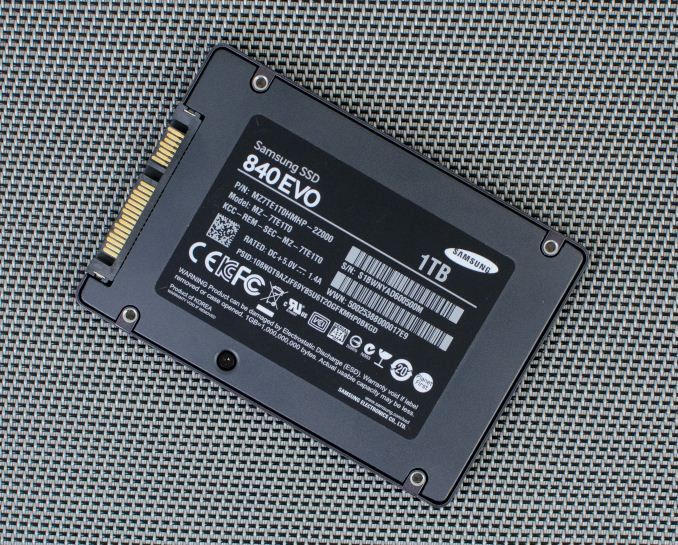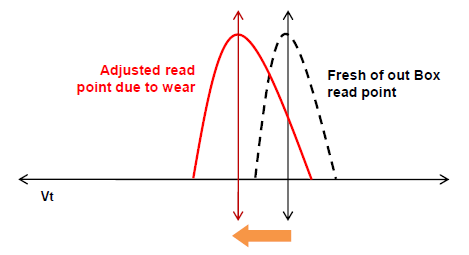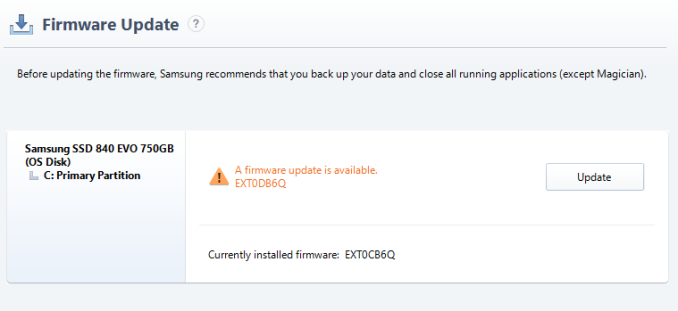Samsung Releases Second 840 EVO Performance Fix
by Ryan Smith on April 27, 2015 6:00 PM EST
If nothing else, the odyssey of Samsung’s 840 EVO has not been lacking in excitement. After initially launching in 2013 to great fanfare as an excellent, strong-performing low-cost drive, over the long run performance regressions began to occur in deployed drives that saw the read performance of old data significantly drop. At the heart of the issue was the drive’s relatively uncommon 19nm TLC NAND, which given the combination of small feature size and tighter requirements of TLC, eventually resulted in the drive having to slow down and re-read cells to properly read the charge-decayed cells.
Aiming to fix the issue, in 2014 Samsung released a performance restoration tool and firmware update for the 840 EVO. The combination of the tool and firmware would update the drive to better handle decayed cells and reduce the need to re-read them, meanwhile the restoration tool would refresh the drive’s data by re-writing all of the data to fresh cells. The idea being that fresh data in combination with the newer firmware would prevent the drive’s performance from decaying again.
Unfortunately that didn’t work out as planned, and while the data refresh from the performance restoration tool did bring drive performance back up, over the long run performance once again began decaying on old data, even with the firmware improvements. As a result Samsung has commissioned a second, more permanent fix for the 840 EVO. This fix involves another firmware update, this time installing a firmware that periodically refreshes old data rather than the one-off refresh of the performance restoration tool. Refreshing the data once again brings performance back up to where it should be, and the periodic, repeating nature of the refresh means that data is never allowed to get too old to let performance degrade again.
Ultimately Samsung’s second fix is a bit of a brute force solution to the problem, but at this point there doesn’t seem to be anything Samsung can do about 19nm TLC cell charge decay other than to refresh the data, as the problem is intrinsic to the NAND itself. Pre-release versions of the firmware show that this fix works, and conceptually this is much more likely to work over the long run than Samsung’s initial fix. The tradeoff is that it does consume P/E cycles to refresh the data, but by our own calculations even 5 years of refreshes at 1/week would only be 26% of the drive’s rated 1000 cycle lifetime. Meanwhile for the longer term, Samsung has since moved on to 3D-VNAND in newer drives, which is more stable than very small geometry planar NAND and essentially turns back the clock on NAND scaling issues. So the 840 EVO should be the last Samsung TLC drive to encounter this issue.
In any case, after previewing the updated firmware to the press, Samsung has released the updated firmware and its associated version of Samsung Magician (version 4.6) to the public over on their website. After an initial staggered release over the weekend – we suspect to make sure not too many users had the firmware if a problem quickly cropped up – Samsung looks to have opened downloads to everyone. However Mac and Linux users will want to note that at this time only the Magician version of the firmware has been released; the bootable ISOs for directly updating the drive have yet to be updated.
In the meantime this will continue to be an issue we keep an eye on. As with the initial problem and Samsung’s first fix, the decay issue only occurs after a time, so we’ll have to see where 840 EVO performance is in a couple months’ time. However with the very nature of the problem and the periodic refreshing of data, we’re hopeful that this will finally put an end to the performance degradation.
Source: Samsung












73 Comments
View All Comments
peterpanty - Tuesday, April 28, 2015 - link
I just installed Samsung Magician 4.6 and upgraded the firmware and ran the optimization - for 30 minutes.Then for fun I ran the optimization again - another 30 minutes.
It is scary that the optimization needs another 30 minutes of optimization.
Should I run it a 3rd time? :-)
megadirk - Tuesday, April 28, 2015 - link
It takes 30 minutes for you to run an optimization? It might take 5 minutes for me.peterpanty - Wednesday, April 29, 2015 - link
Actually it takes more like 45 minutes.Maybe because I have 2 x 40GB files - (Virtual Machines.)
But it is not like the optimization defrags those files - so I do not know why it is taking so long.
WinterCharm - Tuesday, April 28, 2015 - link
I have a question - if I have two partitions on my SSD, do I only need to do the firmware update once?Kristian Vättö - Wednesday, April 29, 2015 - link
Yes. The number of partitions doesn't affect the FW update process.Achaios - Wednesday, April 29, 2015 - link
How to update your drive's firmware (no CD/DVD drive needed, Win 7, 1X840 EVO AHCI):1. If RAPID mode is set to enabled, set it to disable and follow the instructions (reboot).
2. After reboot, install Samsung Magician 4.6. Follow instructions (reboot).
3. After Samsung Magician 4.6 has been successfully installed, open Samsung Magician, click on FIRMWARE UPDATE, click download, and click INSTALL. PC will reboot and the firmware will be updated automatically.
http://i.imgur.com/iQySCuA.jpg (After Firmware Upgrade, RAPID disabled, no perf optimization)
http://i.imgur.com/UZeG44h.jpg (After Firmware Upgrade, RAPID enabled, no perf optimization)
http://i.imgur.com/gs10SLd.jpg (After Firmware Upgrade, RAPID enabled, perf optimized)
Running Performance Optimization REDUCED the Burst Speed on my drive by up to 34.2 MB/sec as well as the average read by up to 1.3 MB/Sec.
skraftnm - Wednesday, April 29, 2015 - link
I'm using rapid storage (50gb as cache for my main hdd). But there are some features like the firmware update that are disable. Does featurea are disabled because i have the cache enable or because i have RAID mode set in the bios?To use ssd as cache i need to have the storage mode set to raid instead of ahci, righ?
dromo - Wednesday, April 29, 2015 - link
Linux users beware, discard and fstrim fail with this brilliant upgrade. OK fstrim, kinda depends on kernel version, but discard may make your disk unmountable.Bravo Samsung, way to go!
leexgx - Thursday, April 30, 2015 - link
still a problem at the Linux kernel not really the SSD itselfdromo - Friday, May 1, 2015 - link
Well, point of view I guess:) but queued trim commands worked fine until this fw relase. Why break it now and make 840 Evo unusable for linux users?